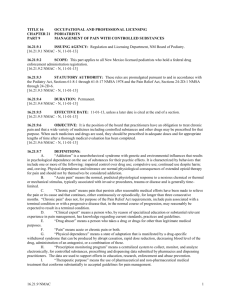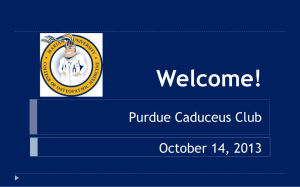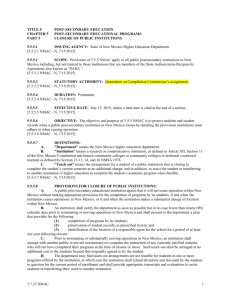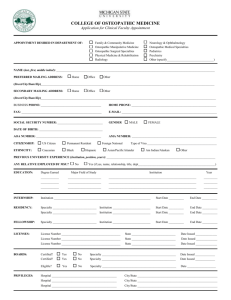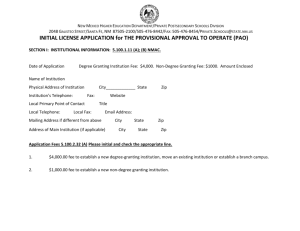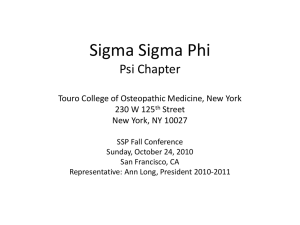TITLE 16 OCCUPATIONAL AND PROFESSIONAL LICENSING
advertisement
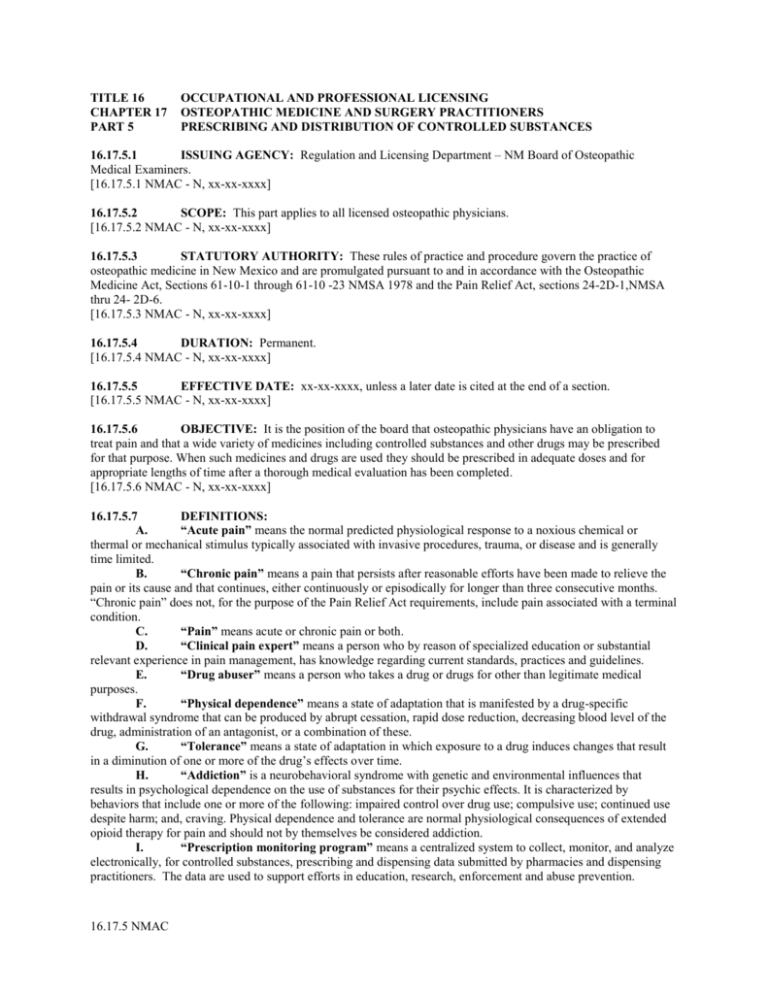
TITLE 16 CHAPTER 17 PART 5 OCCUPATIONAL AND PROFESSIONAL LICENSING OSTEOPATHIC MEDICINE AND SURGERY PRACTITIONERS PRESCRIBING AND DISTRIBUTION OF CONTROLLED SUBSTANCES 16.17.5.1 ISSUING AGENCY: Regulation and Licensing Department – NM Board of Osteopathic Medical Examiners. [16.17.5.1 NMAC - N, xx-xx-xxxx] 16.17.5.2 SCOPE: This part applies to all licensed osteopathic physicians. [16.17.5.2 NMAC - N, xx-xx-xxxx] 16.17.5.3 STATUTORY AUTHORITY: These rules of practice and procedure govern the practice of osteopathic medicine in New Mexico and are promulgated pursuant to and in accordance with the Osteopathic Medicine Act, Sections 61-10-1 through 61-10 -23 NMSA 1978 and the Pain Relief Act, sections 24-2D-1,NMSA thru 24- 2D-6. [16.17.5.3 NMAC - N, xx-xx-xxxx] 16.17.5.4 DURATION: Permanent. [16.17.5.4 NMAC - N, xx-xx-xxxx] 16.17.5.5 EFFECTIVE DATE: xx-xx-xxxx, unless a later date is cited at the end of a section. [16.17.5.5 NMAC - N, xx-xx-xxxx] 16.17.5.6 OBJECTIVE: It is the position of the board that osteopathic physicians have an obligation to treat pain and that a wide variety of medicines including controlled substances and other drugs may be prescribed for that purpose. When such medicines and drugs are used they should be prescribed in adequate doses and for appropriate lengths of time after a thorough medical evaluation has been completed. [16.17.5.6 NMAC - N, xx-xx-xxxx] 16.17.5.7 DEFINITIONS: A. “Acute pain” means the normal predicted physiological response to a noxious chemical or thermal or mechanical stimulus typically associated with invasive procedures, trauma, or disease and is generally time limited. B. “Chronic pain” means a pain that persists after reasonable efforts have been made to relieve the pain or its cause and that continues, either continuously or episodically for longer than three consecutive months. “Chronic pain” does not, for the purpose of the Pain Relief Act requirements, include pain associated with a terminal condition. C. “Pain” means acute or chronic pain or both. D. “Clinical pain expert” means a person who by reason of specialized education or substantial relevant experience in pain management, has knowledge regarding current standards, practices and guidelines. E. “Drug abuser” means a person who takes a drug or drugs for other than legitimate medical purposes. F. “Physical dependence” means a state of adaptation that is manifested by a drug-specific withdrawal syndrome that can be produced by abrupt cessation, rapid dose reduction, decreasing blood level of the drug, administration of an antagonist, or a combination of these. G. “Tolerance” means a state of adaptation in which exposure to a drug induces changes that result in a diminution of one or more of the drug’s effects over time. H. “Addiction” is a neurobehavioral syndrome with genetic and environmental influences that results in psychological dependence on the use of substances for their psychic effects. It is characterized by behaviors that include one or more of the following: impaired control over drug use; compulsive use; continued use despite harm; and, craving. Physical dependence and tolerance are normal physiological consequences of extended opioid therapy for pain and should not by themselves be considered addiction. I. “Prescription monitoring program” means a centralized system to collect, monitor, and analyze electronically, for controlled substances, prescribing and dispensing data submitted by pharmacies and dispensing practitioners. The data are used to support efforts in education, research, enforcement and abuse prevention. 16.17.5 NMAC J. “Prescribe” means to issue an order individually for the person for whom prescribed, either directly from the prescriber to the pharmacist or indirectly by means of a written order signed by the prescriber bearing the name and address of the prescriber, license classification, the name and address of the patient, the name of the drug prescribed, direction for use and the date of issue. K. “Administer” means to apply a prepackaged drug directly to the body of a patient by any means. L. “Dispense” means to deliver a drug directly to a patient and includes the compounding, labeling and repackaging of a drug from a bulk or original container. M. “Distribute” means to administer or supply to a patient under the direct care of the distributing physician or physician assistant one or more doses of drugs prepackaged by a licensed pharmacist and excludes the compounding or repackaging from a bulk or original container. N. “Formulary” means any dangerous drugs; including Schedule II-V controlled substances, physicians may use in the care of patients where there is an established physician-patient relationship. O. “Established physician-patient relationship” means a relationship between a physician and a patient that is for the purpose of maintaining the patient’s well-being. At a minimum, this relationship is established by an interactive encounter between patient and physician involving an appropriate history and physical or mental status examination sufficient to make a diagnosis and to provide, prescribe or recommend treatment, with the informed consent from the patient and availability of the physician or physician assistant or coverage for the patient for appropriate follow-up care. A medical record must be generated by the encounter. P. “Licensed osteopathic physician” means an osteopathic physician licensed by the New Mexico osteopathic board of examiners to practice medicine in New Mexico. [16.17.5.7 NMAC - N, xx-xx-xxxx] 16.17.5.8 GUIDELINES: The following regulations shall be used by the board to determine whether an osteopathic physician's prescriptive practices are consistent with the appropriate treatment of pain. A. The treatment of pain with various medicines or controlled substances is a legitimate medical practice when accomplished in the usual course of professional practice. It does not preclude treatment of patients with addiction, physical dependence or tolerance who have legitimate pain. However, such patients do require very close monitoring and precise documentation. B. The prescribing, ordering, administering or dispensing of controlled substances to meet the individual needs of the patient for management of chronic pain is appropriate if prescribed, ordered, administered or dispensed in compliance with the following. (1) A practitioner shall complete a physical examination and include an evaluation of the patient's psychological and pain status. The medical history shall include any previous history of significant pain, past history of alternate treatments for pain, potential for substance abuse, coexisting disease or medical conditions, and the presence of a medical indication or contra-indication against the use of controlled substances. (2) A practitioner shall be familiar with and employ screening tools as appropriate, as well as the spectrum of available modalities, in the evaluation and management of pain. The practitioner shall consider an integrative approach to pain management. (3) A written treatment plan shall be developed and tailored to the individual needs of the patient, taking age, gender, culture, and ethnicity into consideration, with stated objectives by which treatment can be evaluated, e.g. by degree of pain relief, improved physical and psychological function, or other accepted measure. Such a plan shall include a statement of the need for further testing, consultation, referral or use of other treatment modalities. (4) The practitioner shall discuss the risks and benefits of using controlled substances with the patient, or surrogate, or guardian, and shall document this discussion in the record. (5) Complete and accurate records of care provided and drugs prescribed shall be maintained. When controlled substances are prescribed, the name of the drug, quantity, prescribed dosage and number of refills authorized should be recorded. Prescriptions for opioids shall include indications for use. For chronic non-cancer pain patients treated with controlled substance and analgesic(s), the prescribing practitioner shall use a written agreement for treatment with the patient outlining patient responsibilities. As part of a written agreement, chronic non-cancer pain patients shall receive all chronic pain management prescriptions from one practitioner and one pharmacy whenever possible. (6) The management of patients needing chronic pain control requires monitoring by the attending or the consulting practitioner. The practitioner shall periodically review the course of treatment for chronic non-cancer pain, the patient’s state of health, and any new information about the etiology of the chronic non-cancer pain at least every six months. In addition, a practitioner shall consult, when indicated by the patient’s condition, with a clinical 16.17.5 NMAC pain expert. Consultation should occur early in the course of long-term treatment and at reasonable intervals during continued long-term treatment for assessment of benefit and need a minimum of once every six months. (7) If, in a practitioner’s medical opinion, a patient is seeking pain medication for reasons that are not medically justified, the practitioner is not required to prescribe controlled substances for the patient. C. Pain management for patients with substance abuse disorders shall include: (1) a contractual agreement; (2) appropriate consultation; (3) urine or hair or salivary or blood drug screening shall be considered when other factors suggest an elevated risk of misuse or diversion; and (4) a schedule for re-evaluation at appropriate time intervals at least every six months. D. The board will evaluate the quality of care on the following basis: appropriate diagnosis and evaluation; appropriate medical indication for the treatment prescribed; documented change or persistence of the recognized medical indication; and, follow-up evaluation with appropriate continuity of care. The board will judge the validity of prescribing based on the practitioner’s treatment of the patient and on available documentation, rather than on the quantity and chronicity of prescribing. The goal is to control the patient’s pain for its duration while effectively addressing other aspects of the patient’s functioning, including physical, psychological, social, and work related factors. E. The board will review both over-prescription and under-prescription of pain medications using the same standard of patient protection as a guiding principle. F. Any physician that prescribes opiate based pain medication, shall obtain at least six CME credits in pain management over a three year period. G. Any physician that prescribes opiate based pain medication shall utilize the state based prescription monitoring program at the initial office visit which results in a prescription for an opiate based pain medication, and at least at yearly intervals and at critical turning points in patient care. H. A practitioner who appropriately prescribes controlled substances and who follows this section would be considered to be in compliance with this rule and not be subject to discipline by the board, unless there is some violation of the Osteopathic Medicine and Surgery Practice Act or board rules. [16.17.5.8 NMAC - N, xx-xx-xxxx] 16.17.5.9 PHYSICIANS TREATED WITH OPIATES: Physicians who have chronic pain and are being treated with opiates shall be evaluated by a pain clinic or, by an M.D. or D.O. pain specialist, and must have a complete, independent neuropsychological evaluation, as well as clearance from their physician, before returning to or continuing in practice. In addition, they must remain under the care of a physician for as long as they remain on opiates while continuing to practice. [16.17.5.9 NMAC - N, xx-xx-xxxx] 16.17.5.10 PRESCRIPTION MONITORING PROGRAM (PMP) REQUIREMENTS: The intent of the New Mexico osteopathic medical board in requiring participation in the PMP is to assist practitioners in balancing the promotion of the safe use of controlled substances for the provision of medical care and services with the need to impede illegal and harmful activities involving these pharmaceuticals. A. A health care practitioner who holds a federal drug enforcement administration registration and licensure to prescribe opioids shall register with the board of pharmacy to become a regular participant in PMP inquiry and reporting. B. A health care practitioner shall, before prescribing, ordering, administering or dispensing a controlled substance listed in schedule II, III or IV, obtain a patient PMP report for the preceding 12 months when the patient is a new patient of the practitioner. C. Prescription monitoring reports shall be requested and reviewed a minimum of once every six months during the continuous use of opioids for each established patient. The practitioner shall document the review of these reports. [16.17.5.10 NMAC - N, xx-xx-xxxx] 16.17.5.11 NON-CANCER PAIN MANAGEMENT CONTINUING EDUCATION: This section applies to all New Mexico osteopathic board licensed physicians who hold a federal drug enforcement administration registration and licensure to prescribe opioids. Pursuant to the Pain Relief Act, in order to ensure that all such health care practitioners safely prescribe for pain management and harm reduction, the following rules shall apply. 16.17.5 NMAC A. On or before July 1, 2014 all New Mexico osteopathic medical board licensees who hold a federal drug enforcement administration registration and licensure to prescribe opioids, shall complete no less than two continuing medical education hours in appropriate courses that include a review of 16.17.5 NMAC, management of the treatment of pain, an understanding of the pharmacology and risks of controlled substances, a basic awareness of the problems of abuse, addiction and diversion, and awareness of state and federal regulations for the prescription of controlled substances. All such courses are subject to board approval. Practitioners who have taken continuing education hours in these educational elements in the two years prior to July 1, 2014 may apply those hours toward the required two continuing education hours described in this subsection. B. Beginning with the July 1, 2014 triennial renewal date, as part of the 75 continuing medical education hours required during each triennial renewal cycle, all New Mexico osteopathic board physician licensees, who hold a federal drug enforcement administration registration and license to prescribe opioids, shall be required to complete and submit six continuing education hours. Appropriate courses shall include all of the educational elements described in Subsection A of this section. All such courses are subject to board approval. These hours may be earned at any time during the three-year period immediately preceding the triennial renewal date. The two continuing medical education hours completed prior to July 1, 2014, as defined in Subsection A above, may be included as part of the required continuing medical education hours in pain management. C. All New Mexico osteopathic board licensees, whether or not the New Mexico license is their first license, who hold a federal drug enforcement administration registration and license shall complete two continuing medical education hours in pain management during the first year of licensure. These two continuing medical education hours completed prior to the first renewal may be included as part of the hours required in Subsection B above. [16.17.5.11 NMAC - N, xx-xx-xxxx] 16.17.5.12 NOTIFICATION: In addition to the notice of procedures set forth in the State Rules Act Chapter 14, Article 14, NMSA 1978, the board shall separately notify the following persons of the Pain Relief Act and Part 17 of the New Mexico Osteopathic board rule; A. health care practitioners under its jurisdiction; and B. health care practitioners being investigated by the board in relation to the practitioner’s pain management services. [16.17.5.12 NMAC - N, xx-xx-xxxx] HISTORY OF 16.17.5 NMAC: [RESERVED] 16.17.5 NMAC

